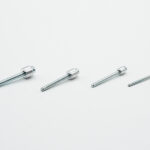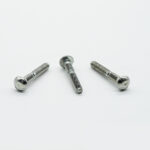Umbrella rivets (also known as lantern rivets) are so named because their shells have hollow grooves and the shells are folded like umbrella bones after riveting.
Generally made of aluminum alloy, they have a large expansion area after riveting and low connection strength. They are generally used to connect soft plastic sheets for automotive interiors.
Bosilong drafted and established the industry standard for umbrella rivets (standard number: JB/T 12790-2016 Umbrella-shaped flat round head blind rivets).
Usage scenarios
Generally made of aluminum alloy, the expansion area after riveting is large, and the connection strength is not high. It is generally used to connect soft plastic plates for automobile interior decoration.
Bosilong drafted and established the industry standard for umbrella rivets (standard number: JB/T 12790-2016 umbrella-shaped flat round head blind rivets).
size
| Product Code | D | L | dk | k | d | P | M | d0 | h | |||
| Nominal | Min | Max | Nominal=Min | Max | Max | Max | Max | Min | Max | refer to | ||
| B1061-032130 | 3.2 | 3.09 | 3.31 | 13 | 14 | 6.6 | 1 | 1.85 | 30 | 17 | 3.4-3.7 | 1.0~3.0 |
| B1061-032190 | 19 | 20 | 23 | 1.0~7.0 | ||||||||
| B1061-032210 | 21 | 22 | 25 | 4.0~9.0 | ||||||||
| B1061-040140 | 4 | 3.89 | 4.11 | 14 | 15 | 8.1 | 1.5 | 2.3 | 30 | 18 | 4.2-4.5 | 1.0~3.0 |
| B1061-040170 | 17 | 18 | 21 | 1.0~6.0 | ||||||||
| B1061-040200 | 20 | 21 | 24 | 1.0~8.0 | ||||||||
| B1061-040250 | 25 | 26 | 29 | 5.0~12 | ||||||||
| B1061-048180 | 4.8 | 4.69 | 4.91 | 18 | 19 | 10 | 2 | 2.9 | 30 | 22.5 | 5.0-5.3 | 1.0~6.4 |
| B1061-048210 | 21 | 22 | 25.5 | 5.6~9.6 | ||||||||
| B1061-048280 | 28 | 29 | 32.5 | 9.0~14 | ||||||||
| B1061-050180 | 5 | 4.89 | 5.11 | 18 | 19 | 12 | 2.2 | 3 | 30 | 23 | 5.2-5.5 | 1.0~6.4 |
| B1061-050250 | 25 | 26 | 30 | 5.6 | ||||||||
Performance Table
| Rivet body diameter D nominal | Tensile strength (N)min |
Shear resistance (N)min |
Nail core breaking force (N)max |
| 3.2 | 800 | 500 | 1000 |
| 4 | 1000 | 600 | 1500 |
| 4.8 | 1100 | 800 | 2500 |
Surface treatment
Installation Method
1.1 Product installation steps
1) Select a pneumatic or battery-powered rivet gun with matching pulling force, install a nozzle with matching diameter specifications, and adjust the appropriate rivet stroke according to the installation thickness and tool manual;
2) Load the product and perform an empty pull test;
3) Perform a real rivet test on the test sheet metal, as shown in step 1 below.
4) Observe whether the clamping state of the product is normal after installation.
5) (To determine whether the installation fails, please refer to the following article – Product installation failure mode pictures)
1.2 Operation steps
Hold the product or the nozzle close to the tail of the rivet to automatically suck in the nail core and the rivet flange surface to ensure that it is close to the nozzle. Insert the tool into the installation hole in a direction perpendicular to the sheet metal plane and close to the sheet metal surface, then pull the trigger to start riveting until the nail core breaks. At this time, one riveting action ends, and then the next working cycle is carried out.




























































